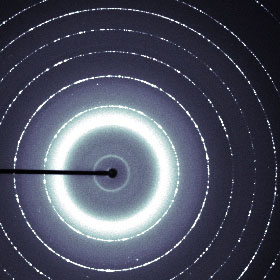Powder/Small Molecule/ Protein Diffraction
The X-ray Powder Diffraction method is one of the few non-destructive methods that permit the identification and the elemental analyze of materials
As the X-ray diffraction pattern of a crystalline substance is unique, it is possible to characterize and thus to identify any polycrystalline substance (phase).
In order to understand the diffraction pattern, either the incident beam is monochromatic or the X-ray detector is able to resolve the energy from the Kα1, Kα2 doublet to the Kβ1 line. Alternatively, Sollers slits / optics can be used in order to select the corresponding angular range.
A resolution better than 450eV is necessary (FWHM of the measured Cu Kα1, Kα2 doublet).
Diffraction patterns consists of rings, high intensity spots due to crystallized materials, which are mixed to the existing phases are averaged over continuous sample rotations. Intensity integration over those rings allows pattern indexation.
Near photon counting sensitivity maybe required for standard laboratory X-ray sources whereas high brilliance sources such as microfocus / synchrotons will require good dynamic range: typically 15,000:1 and large area 165mm diagonal.
We Recommend...
X-Ray sCMOS 16MP Detector X-ray sCMOS 64 MP Detector

Contact Us
22 Theaklen Drive,
Saint Leonards-on-sea,
TN38 9AZ,
United Kingdom


